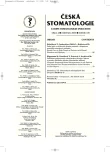-
Medical journals
- Career
Dental Care in Risk Groups of Patients with Mental Disorders and Epilepsy
Authors: Z. Halačková 1; L. Izakovičová Hollá 1,2; M. Kukletová 1
Authors‘ workplace: Stomatologická klinika LF MU a FN, Brno 1; Ústav patologické fyziologie LF MU, Brno 2
Published in: Česká stomatologie / Praktické zubní lékařství, ročník 109, 2009, 4, s. 66-69
Overview
The aim of our study
was to determine quality of dental care in handicapped persons, first of all in patients with the diagnosis of mental retardation and epilepsy. Over the period of 2002-2004, 225 risk patients, who were sent to the Clinics of Stomatology, St. Anne’s University Hospital in Brno for treatment, were examined. Of this number, 104 persons were the patients with the diagnosis of mental retardation and epilepsy and these were split into four subgroups. The first two groups included patients only with the diagnosis of mental retardation or epilepsy, the other two groups contained persons in whom these diseases were combined with another disease. The incidence of dental caries and their treatment was recorded by KPE and RI in both the groups. Compared to the nationwide survey where the average values of 1.79 caries per patient were determined, the average values in the studied set were fourfold higher. There was not any difference in the incidence of caries between the mentally retarded persons, epileptics and the patients in whom epilepsy was combined with another disease. The groups of patients with mental retardation or with this diagnosis in combination with another disease had lower average values of number of fillings (3.43 and 3.64, respectively) than the patients with the diagnosis of epilepsy and epilepsy combined with another general disease (4.47 and 5.50, respectively). KPE values in all the studied groups were high; the group with the diagnosis of mental retardation and mental retardation combined with another disease had lower values (16.66 and 17.48, respectively) than the group of patients with the diagnosis of epilepsy and epilepsy combined with another disease (21.33 and 19.03, respectively). Percentage values of level of treatment in patients with different diagnoses showed low level of treatment in all the studied groups; percentage values of RI were the lowest in the group of patients with mental retardation in combination with another disease or mental retardation alone (32.36 and 34.37, respectively). Our study points to insufficient treatment of the handicapped patients and necessity to improve dental care in these patients.Key words:
patient at risk - mental health - epilepsy - oral health - dental care
Sources
1. Broukal, Z., Mrklas, L., Krejsa, O., Mazánková, V., Pázlerová, V.: Analýza orálního zdraví vybraných věkových skupin obyvatel České republiky 2003. Praha, 2004, 105 s.
2. Dougall, A., Fiske, J.: Access to special care dentistry. Part 4. Education. British Dental Journal, 205, 2008, s. 119-130.
3. Dougall, A., Fiske, J.: Access to special care dentistry. Part 6. Special care dentistry services or young people. British Dental Journal, 205, 2008, s. 235-249.
4. Griffiths, J., Jones,V., Leeman,I., Lewis,D., Patel, K., Wilson, K., Brankenstein, R.: Oral healt care for people with men.tal health problems. British Society for Disability and Oral Health, 2000, 20 s., 1044867.
5. Halačková, Z., Kukletová, M., Izakovičová Hollá, L.: Rizikový pacient a specializovaná zubní péče. Praktické zubní lékařství, 56, 2008, 5, s. 61-65.
Labels
Maxillofacial surgery Orthodontics Dental medicine
Article was published inCzech Dental Journal

2009 Issue 4
Most read in this issue- Repeated Endodontic Treatment
- Dental Care in Risk Groups of Patients with Mental Disorders and Epilepsy
- Nanomaterials in Dentistry – State of The Art
- Computer Supported Dental Reconstruction in the Patients with Abrasion and Temporomandibular Joint Disorders (A Case Report)
Login#ADS_BOTTOM_SCRIPTS#Forgotten passwordEnter the email address that you registered with. We will send you instructions on how to set a new password.
- Career

